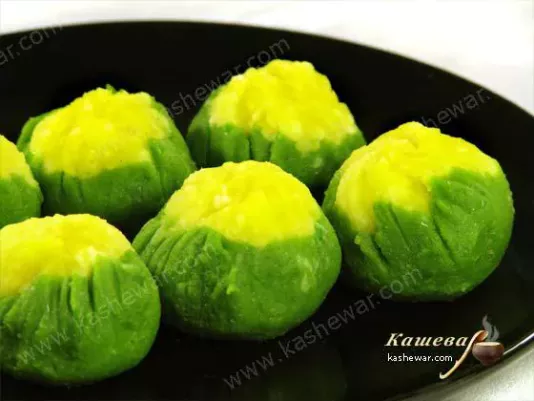Wakame Salad
Wakame salad is a Japanese recipe made from wakame seaweed, sauce and sesame.

Japanese cuisine is not just a national gastronomic tradition but a complete cultural system grounded in harmony, naturalness, and reverence for food. Its foundation lies in fresh ingredients, seasonality, aesthetics, and flavor balance. In Japan, each ingredient is believed to speak for itself, so heat treatment is minimal and seasonings are used only to emphasize the natural aroma. Presentation is especially important – shape, color, and the arrangement of dishes matter. Rice forms the base of most meals, while fish, seafood, vegetables, seaweed, and soy products make up the main components. The cuisine is closely tied to religion, etiquette, and seasonal rituals. Its authenticity, commitment to natural purity, and rejection of excess have made Japanese gastronomy a model for the global culinary community.
Japanese cuisine recipes impress with their conciseness, precision, and philosophy of pure flavor. Most dishes are built on a small number of ingredients carefully selected for taste, texture, and color. For example, sushi is made from rice seasoned with rice vinegar and fresh fish or seafood, complemented by wasabi, soy sauce, and pickled ginger. Miso soup combines dashi (a broth made from seaweed and fish), miso paste, tofu, and green onions. Tempura consists of delicately battered and fried vegetables and seafood. Donburi is a rice bowl topped with eel, tuna, or vegetables. Each recipe precisely defines temperature, cooking time, and the order of steps. Presentation rules are equally important, as the visual aspect of a dish holds as much value as its flavor in Japanese culture. That’s why Japanese recipes are seen not just as instructions but as part of a cultural code.
Japanese cuisine evolved in close connection with religious, social, and natural factors. Buddhism plays a significant role – it prohibited the consumption of meat during certain historical periods, contributing to the development of vegetarian traditions. Later, with Japan’s opening to the outside world, new ingredients and techniques were introduced into gastronomy, but balance and respect for tradition remained central. The principle of "ichi-ju-san-sai" (one soup and three dishes) demonstrates the ideal component ratio for daily meals. Eating is not just a means of nourishment but a form of meditation, gratitude to nature, and health maintenance. Each dish reflects care for both body and soul. This approach shapes not only culinary practice but a lifestyle focused on mindful consumption and inner harmony.
Japanese cuisine is distinguished by a deep understanding of seasonality and local sourcing. Ingredients are selected based on the season to ensure maximum freshness and nutritional value. Key components include rice, soy products (tofu, miso, soy sauce), seafood, seaweed (nori, kombu, wakame), vegetables (daikon, eggplant, pumpkin, spinach), eggs, and chicken. Seasonings are used sparingly – mainly soy sauce, rice vinegar, wasabi, and ginger. Typical combinations include rice with fish or vegetables, miso soup with seaweed, and rice balls (onigiri). Meals are served in small portions, often on separate dishes, with attention to color and texture. This allows focus on each element and creates harmony of flavors. Seasonality also appears in desserts: in winter – sweets made from bean paste, in spring – dishes with cherry blossoms, in autumn – chestnuts and sweet potatoes.
Holidays in Japan are marked by special dishes rich in symbolism. For New Year, osechi-ryori is prepared – a collection of multi-component dishes arranged in special lacquered boxes. Each ingredient carries meaning: black beans symbolize health, dried sardines represent a good harvest, herring roe stands for fertility. During hanami – cherry blossom viewing – picnics with seasonal snacks and sake are held. On Boys’ Day (May 5), rice balls wrapped in oak leaves are made. In festive cuisine, not only the taste but also the form of presentation is essential: colors, textures, and dishware shape the mood of respect and celebration. Every dish is prepared with care, sometimes over several days, highlighting the importance of the occasion. Holiday meals are not just food – they are a way of strengthening social bonds and passing down values.
Today, Japanese cuisine is one of the most influential in the world. Its principles – simplicity, health, aesthetics – form the foundation of numerous culinary schools, restaurants, and food shows. Sushi bars, ramen shops, and bento cafes are opening in many countries. Meanwhile, a new wave is emerging in Japan itself – modern cuisine that combines traditional techniques with foreign ingredients. Examples include sushi with avocado or cream cheese, truffle tempura, and matcha fusion desserts. At the core remains respect for the ingredient and minimalism. There is also growing interest in local farm products, organic farming, and sustainable fishing. Japanese gastronomy continues to inspire chefs and food lovers worldwide, standing as a model of harmonious fusion between culinary heritage and modernity.